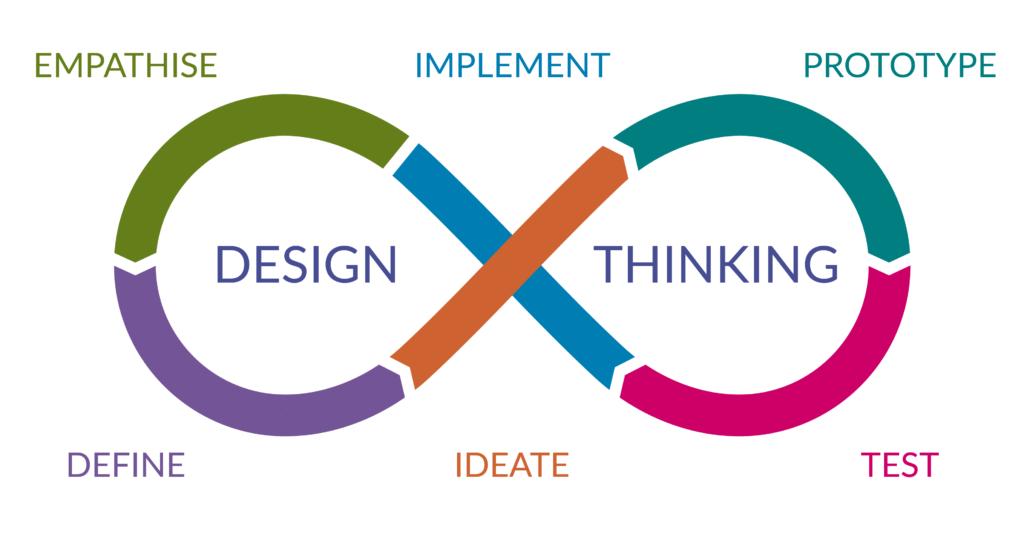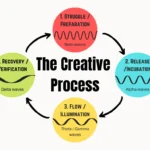
What is design thinking and why is it important?
In the realm of innovation and problem-solving, design thinking has emerged as a transformative approach that enables individuals and organizations to address complex challenges with creativity and efficiency. By emphasizing a human-centered methodology, design thinking integrates the needs of people, the possibilities of technology, and the requirements for business success.
In this story
Definition of Design Thinking
Design thinking is a systematic, iterative process that focuses on understanding the user, challenging assumptions, redefining problems, and creating innovative solutions that can be prototyped and tested. It is characterized by a deep empathy for the end user, a commitment to experimentation, and a focus on collaboration. At its core, design thinking encourages a mindset that embraces ambiguity and uncertainty, recognizing that true innovation often arises from the interplay of diverse ideas and perspectives. This approach is not confined to the design industry alone; it is applicable across various fields, including business, education, healthcare, and social sectors, where complex problems require nuanced solutions.
Historical Context and Evolution
The roots of design thinking can be traced back to the 1960s and 1970s, when pioneering work in design and architecture began to emphasize the importance of human-centered design. Herbert A. Simon’s book, “The Sciences of the Artificial,” published in 1969, laid the groundwork by highlighting the role of design as a way of thinking that could be applied to problem-solving in any discipline. By the 1980s and 1990s, the concept gained momentum as designers like Rolf Faste and David Kelley began to formalize design thinking principles and apply them to business and engineering contexts.
The establishment of IDEO, a global design and consulting firm co-founded by Kelley, marked a pivotal point in the evolution of design thinking. IDEO popularized the approach through high-profile projects, demonstrating how design thinking could drive innovation in product development and organizational strategy. The method gained further academic endorsement with the founding of the Hasso Plattner Institute of Design at Stanford University, commonly known as the d.school, which became a hub for teaching and developing design thinking methodologies.
Over the years, design thinking has evolved from a niche design practice to a mainstream approach embraced by organizations worldwide. Its adaptability and focus on user-centric solutions have made it a vital tool for companies looking to foster innovation, improve customer experiences, and solve complex problems. As industries continue to face rapid technological advancements and shifting consumer expectations, design thinking offers a framework for navigating these changes with agility and creativity.
In conclusion, design thinking is a dynamic and influential methodology that has reshaped the way problems are approached and solutions are devised. By combining empathy, creativity, and rationality, it empowers individuals and organizations to innovate and thrive in an increasingly complex world.
Core Principles of Design Thinking
Design thinking is grounded in a set of core principles that guide its practice and distinguish it from traditional problem-solving methods. These principles emphasize empathy, flexibility, collaboration, and experimentation, creating a robust framework for innovation.
Human-Centered Approach
At the heart of design thinking lies a human-centered approach, which prioritizes understanding and addressing the needs, behaviors, and experiences of users. This principle involves deeply empathizing with individuals to uncover insights that might not be immediately apparent. Techniques such as interviews, observations, and immersion in the user’s environment help designers gain a comprehensive understanding of the context and challenges faced by users. By focusing on the human aspect, design thinking ensures that solutions are not only innovative but also relevant and meaningful to the people they are intended to serve. This empathy-driven approach fosters a connection between the designer and the user, leading to outcomes that are both functional and emotionally resonant.
Iterative Process
Design thinking is inherently iterative, embracing a cyclical process of prototyping, testing, and refining ideas. This iterative nature allows for continuous improvement and adaptation as new insights emerge. Instead of seeking a one-size-fits-all solution, design thinking encourages experimentation and learning from failures. Each cycle of iteration provides valuable feedback that informs subsequent efforts, allowing teams to refine their understanding of the problem and develop more effective solutions. This flexibility is crucial in navigating complex problems, as it accommodates changes and unexpected discoveries, ultimately leading to more robust and innovative outcomes.
Collaboration and Interdisciplinary Teams
Collaboration is a cornerstone of design thinking, emphasizing the value of diverse perspectives and expertise. By bringing together interdisciplinary teams, design thinking leverages the unique skills and insights of individuals from various fields, including design, engineering, business, and social sciences. This diversity fosters creativity and innovation, as team members challenge assumptions and explore different angles of a problem. Collaborative environments encourage open dialogue and the free exchange of ideas, leading to more holistic and well-rounded solutions. The interdisciplinary nature of teams not only enhances creativity but also ensures that solutions are feasible and practical across different domains.
Prototyping and Testing
Prototyping and testing are essential components of the design thinking process, facilitating the transformation of abstract ideas into tangible concepts. Prototypes can range from simple sketches and models to more sophisticated simulations or digital applications. The goal of prototyping is to visualize and explore ideas quickly and inexpensively, allowing teams to test assumptions and gather feedback from users. Testing these prototypes with real users provides critical insights into how the solution performs in practice and whether it meets the intended needs. This hands-on approach to problem-solving enables teams to identify potential issues early and make necessary adjustments before full-scale implementation.
In summary, the core principles of design thinking—human-centeredness, iteration, collaboration, and prototyping—provide a comprehensive framework for tackling complex challenges. By integrating these elements, design thinking fosters an environment where creativity and practicality converge, leading to solutions that are both innovative and deeply aligned with user needs.
Phases of Design Thinking

Design thinking is structured around a series of distinct yet interconnected phases that guide practitioners from understanding a problem to implementing a solution. These phases—empathize, define, ideate, prototype, and test—are iterative and often overlap, allowing for a dynamic and flexible approach to innovation.
Empathize
The empathize phase serves as the foundation for the entire design thinking process. It involves gaining a deep understanding of the users and their experiences, needs, and challenges. This phase relies heavily on qualitative research methods such as interviews, observations, and immersion in the user’s environment. By empathizing with users, designers can uncover insights that may not be immediately apparent through quantitative analysis alone. This deep, empathetic understanding ensures that the solutions developed are genuinely relevant and valuable to the people they are intended to serve. It creates a user-centric perspective that guides the subsequent phases of the design thinking process.
Define
Building on the insights gathered during the empathize phase, the define phase focuses on clearly articulating the problem to be addressed. This involves synthesizing the information collected and identifying patterns or themes that emerge from the user research. The goal is to create a well-defined problem statement that captures the core issues and opportunities discovered. A strong problem statement is user-centered, actionable, and open-ended, allowing for creative exploration in the ideation phase. By framing the problem effectively, designers set the stage for generating innovative solutions that are both targeted and impactful.
Ideate
The ideate phase is where creativity and innovation take center stage. Armed with a clear problem statement, designers engage in brainstorming sessions to generate a wide range of ideas and potential solutions. This phase encourages thinking outside the box and challenging existing assumptions, fostering an environment where unconventional ideas are welcomed and explored. Techniques such as mind mapping, sketching, and role-playing can be employed to stimulate creative thinking. The aim is to generate as many ideas as possible, recognizing that even seemingly far-fetched concepts can lead to breakthrough innovations. This diverse pool of ideas serves as the basis for developing prototypes in the next phase.
Prototype
During the prototype phase, selected ideas from the ideation process are transformed into tangible representations. Prototypes can take various forms, from simple sketches and models to more sophisticated digital interfaces and simulations. The purpose of prototyping is to bring ideas to life quickly and cost-effectively, allowing designers to explore their feasibility and functionality. Prototyping is inherently experimental, and the artifacts created are not meant to be perfect. Instead, they serve as tools for learning and exploration, enabling designers to test assumptions and gather feedback from users and stakeholders.
Test
The test phase involves evaluating the prototypes with real users to gather insights into how well the proposed solutions meet their needs. Testing is a critical step in the design thinking process, as it provides direct feedback on the usability, effectiveness, and desirability of the prototypes. Through user testing, designers can identify potential flaws, gather suggestions for improvement, and gain a deeper understanding of user interactions with the solution. This feedback is invaluable for refining and iterating on the prototypes, ensuring that the final solution is well-aligned with user expectations and requirements.
Together, these phases of design thinking create a comprehensive framework for innovation that is both user-centric and adaptable. By continuously cycling through these stages, designers can develop solutions that are not only innovative but also deeply rooted in the needs and experiences of the users they serve.
Applications of Design Thinking
Design thinking has gained widespread recognition across various fields for its ability to foster creativity, enhance problem-solving, and drive innovation. Its principles have been successfully applied in numerous contexts, from business and product development to social issues and customer experience.
Business Innovation
In the realm of business innovation, design thinking serves as a powerful tool for companies aiming to stay competitive in an ever-evolving market landscape. By adopting a human-centered approach, businesses can better understand and anticipate customer needs and market trends. This understanding leads to the development of new business models, services, and processes that align more closely with user expectations. Design thinking encourages organizations to look beyond conventional wisdom and explore creative solutions that can lead to disruptive innovations. It fosters a culture of experimentation and iterative learning, enabling companies to pivot quickly and adapt to changes in the market.
Product Development
Design thinking is particularly valuable in product development, where it helps teams create products that resonate with users’ needs and preferences. The iterative nature of design thinking allows for rapid prototyping and testing, ensuring that products are refined based on real user feedback before reaching the market. This process reduces the risk of failure and increases the likelihood of success by aligning product features with user desires. By involving users throughout the development process, companies can create more intuitive and user-friendly products that stand out in a crowded marketplace. The empathetic focus of design thinking ensures that products are not only functional but also emotionally engaging for users.
Social and Public Sector Solutions
Beyond the commercial sphere, design thinking has made significant inroads in addressing complex social and public sector challenges. Governments, non-profits, and social enterprises have adopted design thinking to innovate in areas such as healthcare, education, and urban planning. The methodology’s emphasis on empathy and understanding of human behavior is particularly useful in these contexts, where solutions must cater to diverse community needs and constraints. Design thinking facilitates the co-creation of solutions with stakeholders, ensuring that interventions are grounded in the lived experiences of those they aim to assist. This collaborative approach helps build more inclusive, equitable, and sustainable solutions to societal issues.
Enhancing Customer Experience
Enhancing customer experience is another area where design thinking has proven to be invaluable. By placing the customer at the center of the design process, organizations can identify pain points and opportunities for improvement across the customer journey. Design thinking helps businesses craft personalized experiences that foster loyalty and satisfaction. From redesigning physical spaces to reimagining digital interfaces, the approach encourages companies to view their offerings through the lens of the customer, leading to meaningful interactions and stronger brand connections. By continuously iterating and refining these experiences, companies can ensure they remain relevant and responsive to changing customer expectations.
In all these applications, design thinking provides a structured yet flexible framework that encourages creativity, collaboration, and a deep understanding of user needs. Its adaptability and focus on human-centered solutions make design thinking an essential methodology for driving innovation and creating value across diverse domains.
Importance of Design Thinking
Design thinking has emerged as an essential methodology in today’s fast-paced and complex world, offering a unique approach that combines creativity, empathy, and iterative problem-solving to tackle a wide range of challenges. Its importance is underscored by its ability to foster innovation, solve complex problems, promote user-centered solutions, and drive competitive advantage.
Fostering Innovation and Creativity
At its core, design thinking is a catalyst for innovation and creativity. By encouraging teams to explore a wide array of possibilities and challenge conventional assumptions, design thinking creates an environment where novel ideas can flourish. Its emphasis on brainstorming and divergent thinking helps break down barriers to creativity, allowing individuals and teams to imagine solutions that transcend traditional boundaries. This creative freedom is vital for innovation, enabling organizations to introduce groundbreaking products, services, and processes that capture the imagination of users and stakeholders alike. Design thinking’s structured approach to creativity ensures that these ideas are not only inventive but also feasible and actionable.
Solving Complex Problems
Design thinking is particularly adept at addressing complex, multifaceted problems that lack clear solutions. By employing a human-centered approach, it prioritizes understanding the nuances of a problem from the perspective of those affected. This deep empathy allows teams to uncover insights that might otherwise remain hidden, leading to more comprehensive and effective solutions. The iterative nature of design thinking—where ideas are continuously prototyped, tested, and refined—allows for the exploration of multiple pathways to a solution, accommodating changes and new information as they arise. This adaptability is crucial in tackling the ambiguity and uncertainty inherent in complex challenges, ensuring that solutions are robust and resilient.
Promoting User-Centered Solutions
One of the defining features of design thinking is its commitment to putting the user at the center of the design process. This user-centric focus ensures that solutions are tailored to meet the genuine needs and desires of the target audience. By engaging users throughout the development process, design thinking fosters a deeper understanding of their experiences, pain points, and aspirations. This engagement leads to solutions that are not only functional but also resonate with users on an emotional level, enhancing satisfaction and loyalty. The emphasis on user-centered design helps organizations build more meaningful and lasting relationships with their customers, stakeholders, and communities.
Driving Competitive Advantage
In a highly competitive global market, design thinking offers a strategic edge by enabling organizations to differentiate themselves through innovation and customer experience. Its holistic approach helps businesses identify unique value propositions and develop offerings that stand out from the competition. By continuously iterating and refining products and services based on user feedback, organizations can remain agile and responsive to changing market demands. This agility is a key factor in maintaining a competitive advantage, as it allows companies to adapt swiftly to technological advancements and evolving consumer preferences. Design thinking’s ability to integrate creativity with strategic business objectives ensures that organizations are well-positioned to capture new opportunities and sustain long-term growth.
In conclusion, the importance of design thinking lies in its ability to transform how organizations approach innovation and problem-solving. By fostering creativity, addressing complexity, centering on user needs, and enhancing competitiveness, design thinking equips organizations with the tools to navigate an increasingly complex and dynamic world effectively.
Challenges and Limitations
While design thinking is celebrated for its innovative approach and problem-solving capabilities, it is not without its challenges and limitations. Understanding these potential obstacles is crucial for organizations seeking to effectively implement design thinking in their operations.
Misunderstanding the Process
One of the primary challenges associated with design thinking is the frequent misunderstanding of its process and principles. Often perceived merely as a set of creative exercises or brainstorming activities, design thinking’s depth and rigor can be underestimated. This misunderstanding can lead to superficial applications that fail to achieve meaningful outcomes. Design thinking is a comprehensive methodology that requires a disciplined approach, integrating empathy, iteration, and collaboration into every phase. Without a proper understanding and commitment to its principles, organizations risk reducing design thinking to a series of disconnected activities, thereby undermining its potential impact.
Implementation Barriers
Implementing design thinking within an organization can encounter several barriers. Cultural resistance is a common challenge, as the collaborative and iterative nature of design thinking may clash with traditional hierarchical structures and decision-making processes. Organizations accustomed to linear, top-down approaches may struggle to embrace the flexible and exploratory mindset that design thinking demands. Additionally, the requirement for cross-functional collaboration can be hindered by departmental silos and internal politics. Overcoming these barriers often necessitates a significant cultural shift and a commitment to fostering an environment conducive to experimentation and open communication. Organizational leaders play a crucial role in championing design thinking and facilitating the structural changes needed to support its adoption.
Measuring Impact and Success
Another limitation of design thinking is the difficulty in measuring its impact and success. The qualitative nature of design thinking, with its focus on empathy and user experience, can challenge traditional metrics that prioritize quantitative outcomes. Organizations often seek tangible returns on investment, yet the value of design thinking is not always immediately evident in financial terms. This can lead to skepticism about its effectiveness and hesitancy to allocate resources to its implementation. To address this, organizations need to develop new metrics that capture the broader benefits of design thinking, such as improved customer satisfaction, enhanced innovation capacity, and increased employee engagement. These metrics should align with the organization’s strategic goals and provide a more comprehensive view of the value design thinking delivers.
In summary, while design thinking offers a powerful framework for innovation, its successful application requires a clear understanding of its process, an organizational culture that supports its principles, and appropriate metrics to evaluate its impact. By addressing these challenges, organizations can unlock the full potential of design thinking and leverage it as a catalyst for transformative change.
Conclusion
As we conclude the exploration of design thinking, it is essential to reflect on its core principles and the transformative impact it has had across various sectors. Design thinking has emerged as a critical methodology for fostering innovation, addressing complex challenges, and creating user-centered solutions that drive competitive advantage.
Recap of Key Points
Throughout our discussion, we highlighted the fundamental aspects of design thinking, including its human-centered approach, iterative process, and emphasis on collaboration. These principles collectively enable organizations to empathize with users, define clear problem statements, and ideate innovative solutions through prototyping and testing. By prioritizing the needs and experiences of users, design thinking ensures that solutions are not only functional but also deeply aligned with user expectations.
We examined the diverse applications of design thinking, ranging from business innovation and product development to tackling social issues and enhancing customer experience. Each application underscores design thinking’s versatility and its capacity to generate value across different domains. However, we also acknowledged the challenges and limitations that organizations may face, such as misunderstandings of the process, implementation barriers, and difficulties in measuring impact. Addressing these challenges requires a comprehensive understanding of design thinking and a commitment to cultural and organizational change.
Future Outlook for Design Thinking
Looking to the future, the relevance and importance of design thinking are poised to grow as organizations navigate an increasingly complex and dynamic environment. The rapid pace of technological advancement, coupled with shifting consumer expectations, demands innovative approaches that can adapt to change. Design thinking, with its emphasis on empathy, creativity, and collaboration, is well-positioned to meet these demands by providing a structured yet flexible framework for innovation.
As design thinking continues to evolve, we can anticipate its integration with emerging technologies such as artificial intelligence, data analytics, and virtual reality. These technologies have the potential to enhance the design thinking process by providing new tools for understanding user needs, generating ideas, and prototyping solutions. Additionally, the growing emphasis on sustainability and social responsibility will likely drive the application of design thinking to address global challenges such as climate change, inequality, and public health.
In conclusion, design thinking represents a paradigm shift in how organizations approach problem-solving and innovation. Its enduring impact lies in its ability to transform challenges into opportunities for growth and improvement, making it an indispensable tool for future-ready organizations. By embracing design thinking’s principles and addressing its challenges, organizations can unlock new possibilities and create meaningful value in an ever-changing world.




Leave a Reply